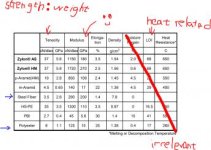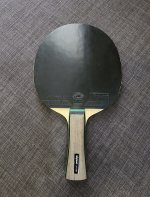This user has no status.
This user has no status.
Member
What is ZLF?
"ZLF is pure Zylon, and is about $50 a square yard in raw fabric, with good hardener costing about $20. It is just named ballistic zylon, which means that only zylon is in it. It is sold in a weave pattern." (iliketurtles, 10-12-2011)
What is ZLC?
"ZLC is a carbon-zylon weave, and is heavier and harder (so faster for table tennis), and costs $144 a linear yard to buy a sheet that has already been hardened, though if you get over 10 sheets, it is $130 a linear yard. This is zylon and carbon weaved tightly together in a 2x2 twill pattern."(iliketurtles, 10-12-2011)
so obviously ZLC>ZLF for hardness due to the carbon
What about ALC?
I tried to search about "arylate carbon" but I seems to be all about butterfly yet no scientific date on this material. Probably because it is not a pure material but 2 materials that are weaved together for table tennis use. As a result, there is no available data out there that is on something that is so specific.
I suppose my research on Zylon is meaningless as there is not possible to compare to ALC.
as there is not possible to compare to ALC.

(TOYOBO CO., LTD. , 2005)
So I turned to the famous–or infamous for some of its inaccurate numbers–Revspin for user ratings
Here are 7 ALC blades from butterfly (Excluding Harimoto & Matsudaira because they have less than 10 reviews) (I know 10 is very arbitrary and I cannot justify this number)
Here are 4 ZLF blades from butterfly (Excluding Innershield, Liu Shiwen, Innershield Layer) (below 10 ratings)
It seems like there are more ALC reviews than ZLF reviews.
Conclusion:
Speed: ALC>ZLF by 0.2 so not a lot
control: ZLF>ALC by 0.2 so again not a lot
stiffness: ALC>ZLF by 1.0 so quite substantial
hardness: ALC>ZLF by 0.5 so difference is there
price: ZLF>ALC by 15.21 USD
Pros for ZLF:
It seems like ZLF is softer so longer dwell time and possibly more feeling as there is no carbon layer in it but it is slightly slower.
What does it mean? I'm not a advanced player but I guess it is better for looping that packs spin, picking up low or backspin balls and more forgiving. (the usual things that reviewers say
 )
)
Pros for ALC:
On the other hand ALC is a bit faster which is good for obvious reasons given that you can handle it. It is stiffer and harder so better for smashing and close to the table style due to the lower arc produced. It is cheaper; Although not significantly, you need to take it into a count. There are alot more ALC available out there than ZLF.
But keep in mind that these are all in relative terms.
Reference:
iliketurtles, 10-12-2011, https://ooakforum.com/viewtopic.php?t=18135
TOYOBO CO., LTD., 2005, https://www.toyobo-global.com/seihin/kc/pbo/zylon-p/bussei-p/technical.pdf
https://revspin.net/blade/
https://shop.butterflyonline.com/
https://thorntonstabletennis.co.uk/
Tell me your experience with the two materials. I would love to know your opinions.
"ZLF is pure Zylon, and is about $50 a square yard in raw fabric, with good hardener costing about $20. It is just named ballistic zylon, which means that only zylon is in it. It is sold in a weave pattern." (iliketurtles, 10-12-2011)
What is ZLC?
"ZLC is a carbon-zylon weave, and is heavier and harder (so faster for table tennis), and costs $144 a linear yard to buy a sheet that has already been hardened, though if you get over 10 sheets, it is $130 a linear yard. This is zylon and carbon weaved tightly together in a 2x2 twill pattern."(iliketurtles, 10-12-2011)
so obviously ZLC>ZLF for hardness due to the carbon
What about ALC?
I tried to search about "arylate carbon" but I seems to be all about butterfly yet no scientific date on this material. Probably because it is not a pure material but 2 materials that are weaved together for table tennis use. As a result, there is no available data out there that is on something that is so specific.
I suppose my research on Zylon is meaningless

(TOYOBO CO., LTD. , 2005)
So I turned to the famous–or infamous for some of its inaccurate numbers–Revspin for user ratings
Here are 7 ALC blades from butterfly (Excluding Harimoto & Matsudaira because they have less than 10 reviews) (I know 10 is very arbitrary and I cannot justify this number)
| speed | control | stiffness | hardness | price in USD(official web) | |
| FREITAS | 9.0 | 9.5 | 5.7 | 6.2 | 215.99 |
| garaydia | 8.8 | 8.7 | 5.4 | 6.0 | 172.99 |
| Innerforce Layer | 9.1 | 9.4 | 4.3 | 5.0 | 172.99 |
| Innerforce Layer ALC.S | 8.5 | 9.3 | 4.1 | 3.9 | 179.99 |
| Marcos Freitas | 9.0 | 9.2 | 5.0 | 5.2 | 215.99 |
| timo boll | 8.9 | 8.6 | 5.7 | 6.1 | 159.99 |
| Zhang Jike | 9.2 | 9.0 | 5.7 | 5.4 | 181.97 |
| mean(1 d.p.)& (2 d.p.) | 8.9 | 9.1 | 5.1 | 5.4 | 184.70 |
Here are 4 ZLF blades from butterfly (Excluding Innershield, Liu Shiwen, Innershield Layer) (below 10 ratings)
It seems like there are more ALC reviews than ZLF reviews.
| speed | control | stiffness | hardness | price in USD | |
| Fukuhara Ai Pro | 8.8 | 9.4 | 4.3 | 4.6 | 219.90 not sold in butterfly official so I went to thornton |
| Innerforce Layer | 8.2 | 9.6 | 3.5 | 4.5 | 201.99 |
| Innerforce | 8.9 | 9.0 | 3.8 | 4.8 | 170 but not sold anymore...I think |
| Timo Boll | 8.8 | 9.3 | 5.1 | 5.5 | 207.73 thornton |
| mean (1 d.p.) | 8.7 | 9.3 | 4.1 | 4.9 | 199.91 |
Conclusion:
Speed: ALC>ZLF by 0.2 so not a lot
control: ZLF>ALC by 0.2 so again not a lot
stiffness: ALC>ZLF by 1.0 so quite substantial
hardness: ALC>ZLF by 0.5 so difference is there
price: ZLF>ALC by 15.21 USD
Pros for ZLF:
It seems like ZLF is softer so longer dwell time and possibly more feeling as there is no carbon layer in it but it is slightly slower.
What does it mean? I'm not a advanced player but I guess it is better for looping that packs spin, picking up low or backspin balls and more forgiving. (the usual things that reviewers say
Pros for ALC:
On the other hand ALC is a bit faster which is good for obvious reasons given that you can handle it. It is stiffer and harder so better for smashing and close to the table style due to the lower arc produced. It is cheaper; Although not significantly, you need to take it into a count. There are alot more ALC available out there than ZLF.
But keep in mind that these are all in relative terms.
Reference:
iliketurtles, 10-12-2011, https://ooakforum.com/viewtopic.php?t=18135
TOYOBO CO., LTD., 2005, https://www.toyobo-global.com/seihin/kc/pbo/zylon-p/bussei-p/technical.pdf
https://revspin.net/blade/
https://shop.butterflyonline.com/
https://thorntonstabletennis.co.uk/
Tell me your experience with the two materials. I would love to know your opinions.
Last edited:













